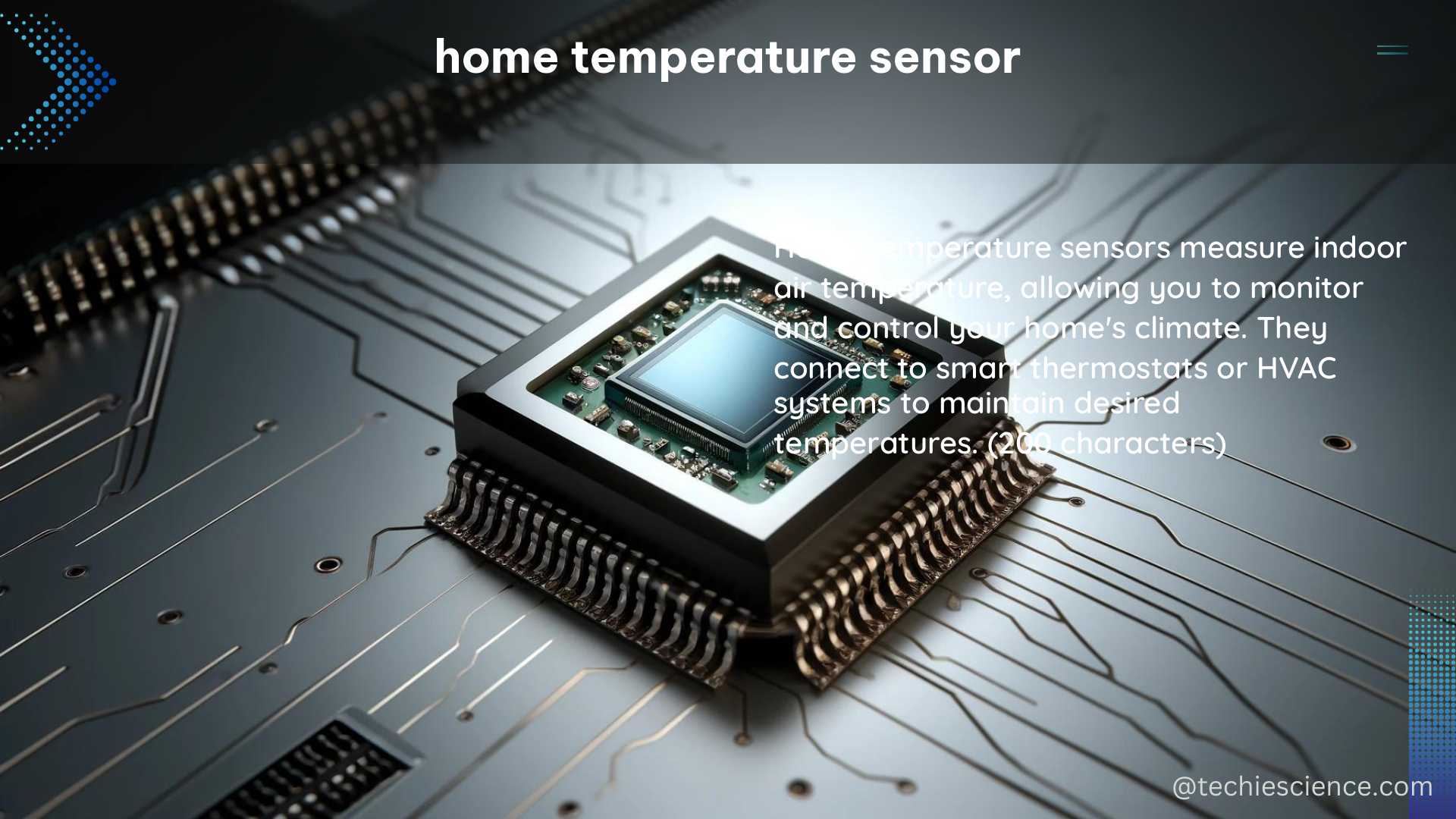Home temperature sensors are essential devices for maintaining a comfortable living environment. These sensors measure the temperature within a home or building and are typically connected to a thermostat, which regulates the heating and cooling systems. The temperature sensor can be a standalone device or integrated into other smart home automation systems.
Types of Home Temperature Sensors
There are two main types of temperature sensors used in home applications: semiconductor-based sensors and resistance temperature detectors (RTDs).
Semiconductor-based Sensors
Semiconductor sensors, such as thermistors and diode-connected bipolar transistors, are commonly used in home temperature sensors due to their ease of integration, ruggedness, and low cost. These sensors measure temperature by detecting changes in voltage or resistance across a p-n junction or semiconductor material.
Key Specifications:
– Operating Range: -55°C to +150°C
– Accuracy: ±0.1°C to ±2°C, depending on the model
Resistance Temperature Detectors (RTDs)
RTDs use a coil of fine wire, usually platinum, to measure temperature based on the change in resistance with temperature. RTDs are known for their high accuracy and stability but are more expensive than semiconductor sensors.
Key Specifications:
– Operating Range: -200°C to +850°C
– Accuracy: ±0.03°C to ±0.1°C
DIY Home Temperature Sensor Projects

For those interested in a DIY approach, there are several options for building a home temperature sensor using popular microcontroller platforms.
Arduino-based Temperature Sensor
One approach is to use an Arduino microcontroller and a temperature sensor module, such as a DS18B20 or a thermistor. The Arduino can be programmed to read the temperature data from the sensor and send it to a computer or a smartphone app for monitoring.
Key Components:
– Arduino microcontroller (e.g., Arduino Uno, Arduino Nano)
– Temperature sensor module (e.g., DS18B20, thermistor)
– Wiring, breadboard, and other necessary components
Raspberry Pi-based Temperature Sensor
Another option is to use a Raspberry Pi and a temperature sensor hat, such as the Adafruit AM2302 or the DHT11. The Raspberry Pi can be configured to send temperature data to a cloud-based platform for remote monitoring and analysis.
Key Components:
– Raspberry Pi (e.g., Raspberry Pi 4 Model B)
– Temperature sensor hat (e.g., Adafruit AM2302, DHT11)
– Wiring, breadboard, and other necessary components
Advanced Home Temperature Sensor Features
In addition to basic temperature measurement, modern home temperature sensors can offer advanced features for enhanced comfort and energy efficiency.
Wireless Connectivity
Some home temperature sensors come with wireless connectivity, allowing them to communicate with a central hub or smart home controller. This enables remote monitoring and control of the heating and cooling systems.
Wireless Protocols:
– Wi-Fi
– Bluetooth
– Zigbee
– Z-Wave
Programmable Thermostat Integration
Many home temperature sensors are designed to integrate with programmable thermostats, enabling automated temperature control based on schedules, occupancy, and other factors.
Thermostat Integration Features:
– Setpoint adjustment
– Heating and cooling mode control
– Schedule programming
– Occupancy detection
Smart Home Integration
Home temperature sensors can be integrated into broader smart home automation systems, allowing for seamless control and optimization of the home’s climate and energy usage.
Smart Home Integration Platforms:
– Amazon Alexa
– Google Home
– Apple HomeKit
– Samsung SmartThings
– IFTTT (If This Then That)
Conclusion
Home temperature sensors are essential devices for maintaining a comfortable living environment. By understanding the different types of sensors, their technical specifications, and the various DIY project options, homeowners and DIY enthusiasts can create customized temperature monitoring and control solutions for their homes.
References:
- Gyorki, L. (2009). Sensor technology handbook. McGraw-Hill Professional.
- Fraden, J. (2010). Handbook of modern sensors: physics, design, and applications. Springer Science & Business Media.
- CAPGO. (2010). Sensor technology for industrial automation. John Wiley & Sons.
- Wang, X., et al. (2011). Introduction to the key sensing modalities. In Sensing and sensor fundamentals (pp. 15-44). Springer.
- Lupton, D. (2016). The quantified self: A sociology of self-tracking. Polity.
- Nur Lalji, F. (2019). Featurization and the myth of data empowerment. Washington Journal of Law, Technology & Arts, 15(1), 1-22.
- Elvy, S. A. (2017). Hybrid transactions and the internet of things: Goods, services, or software?. Washington and Lee Law Review, 74(1), 77-138.
- Brill, J. B., & Jones, M. (2016). The internet of things and the future of law. Fordham Law Review, 84(5), 1187-1236.

The lambdageeks.com Core SME Team is a group of experienced subject matter experts from diverse scientific and technical fields including Physics, Chemistry, Technology,Electronics & Electrical Engineering, Automotive, Mechanical Engineering. Our team collaborates to create high-quality, well-researched articles on a wide range of science and technology topics for the lambdageeks.com website.
All Our Senior SME are having more than 7 Years of experience in the respective fields . They are either Working Industry Professionals or assocaited With different Universities. Refer Our Authors Page to get to know About our Core SMEs.